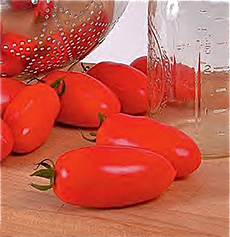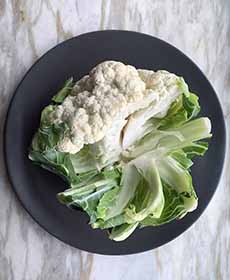RECIPE: Spaghetti With A Surprise Cream Sauce
|
The first surprise in this spaghetti dish with creamy tomato sauce (photo #1) is that there’s no cream, butter or cheese in the sauce. This San Marzano tomato-based pasta sauce recipe from DeLallo is so creamy, you’d think it would be loaded with cream, butter, and/or cheese. The second surprise is that the creaminess comes from a vegetable: cauliflower. It’s not “just” a vegetable: Cauliflower is one of the anti-carcinogenic Brassica family of cruciferous vegetables, which also includes arugula, bok choy, broccoli, Brussels sprouts, cabbage, horseradish/wasabi, kale, kohlrabi, mustard, radishes, rapeseed/canola, rapini, rutabaga and turnips, among others. So if you’ve embarked on a more sustainable diet for the new year, try this vegan recipe. You won’t notice the absence of dairy. Using whole wheat pasta gives it another better-for-you bonus. Ingredients For 4 Servings 1. PLACE a large pot of water seasoned with salt to boil. This will be used to cook the cauliflower and pasta. Meanwhile… 2. ADD the olive oil and garlic to a large sauté pan over medium heat and sauté until fragrant, 1-2 minutes. Add the red pepper flakes and tomato paste, and sauté for another 30 seconds. Finally, add the San Marzano tomatoes. Cook until bubbling, then remove from the heat and set aside. 3. ADD the cauliflower to the boiling water, lower the heat and boil for 5-8 minutes, or until fork-tender. Transfer to the tomato sauce with tongs, leaving the water in the pot to boil. 4. USE the boiling water to cook the pasta, according to package instructions. Meanwhile… 5. CAREFULLY TRANSFER the tomato sauce mixture to a blender and blend until completely smooth. Pour the sauce back into the pan. Once your pasta is al dente… 6. DRAIN and add it to the tomato sauce. Mix to combine. Season with salt and pepper and serve. Don’t throw away the rest of the cauliflower. The stalks, base and leaves comprise some two-thirds of the cauliflower. They’re just as delicious as the florets. |
|
|
|
WHAT ARE SAN MARZANO TOMATOES? These prized Italian tomatoes, which are D.O.P.-protected (Denominazione d’Origine Protetta), are grown in the nutrient-rich volcanic soil around Mt. Vesuvius. An heirloom variety of plum tomatoes, they are naturally so sweet that you’d swear that a can of San Marzanos has added sugar—but it doesn’t. Tomatoes originated in Peru. The story is that the first seeds to become San Marzano tomatoes came to Campania, Italy in 1770, as a gift from the Kingdom of Peru to the Kingdom of Naples. The seeds were planted in the area that is the present-day commune of San Marzano, a small town southeast of Naples at the base of Mount Vesuvius. The volcanic soil is believed to act as a filter for water impurities, producing a lower-acidity, brighter-flavored tomato. The pulp is dense, and because of the lower acidity, the tomatoes have a deeper tomato flavor and a natural sweetness. Sauces made with them require no additional sugar. Even the juice in the can that streams from the diced tomatoes tastes like the best tomato juice! While the varietal is grown in the U.S. and worldwide, the original San Marzanos, imported canned from Italy (photo #2), benefit greatly from the volcanic soil. If you grow the seeds in your own soil, you may not get the same level of sweetness. But try it: The seeds are easily available online. They look similar, but compared to the well-known Roma variety of plum tomatoes, San Marzano tomatoes have an elongated oblong shape—thinner and pointier, believed to be a mutation (photo #3). San Marzanos have only two seed pockets, while most tomatoes have five to seven. Since seeds contribute acidity, this feature also accounts for the lower acidity. The San Marzano is so distinctive and high quality that it is the only variety that can be used to make certified Neapolitan pizza. Here’s more about San Marzano tomatoes.
|
||



